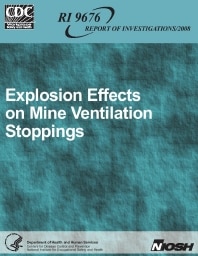Mining Publication: Explosion Effects on Mine Ventilation Stoppings
Original creation date: November 2008
Authors: ES Weiss, KL Cashdollar, SP Harteis, GJ Shemon, DA Beiter, JE Urosek
NIOSHTIC2 Number: 20034708
Pittsburgh, PA: U.S. Department of Health and Human Services, Public Health Service, Centers for Disease Control and Prevention, National Institute for Occupational Safety and Health, DHHS (NIOSH) Publication No. 2009-102, Report of Investigations 9676, 2008 Nov; :1-105
The National Institute for Occupational Safety and Health (NIOSH) and the Mine Safety and Health Administration (MSHA) conducted joint research to evaluate explosion blast effects on typical U.S. mine ventilation stoppings in the Pittsburgh Research Laboratory (PRL) Lake Lynn Experimental Mine (LLEM). An innovative Australian-designed brattice stopping was also evaluated. After mine explosion accidents, MSHA conducts investigations to determine the cause(s) as a means to prevent future occurrences. As part of these postexplosion investigations, the condition of underground stoppings, including the debris from damaged stoppings, is documented as evidence of the approximate strength and the direction of the explosion forces. The LLEM data showed that a typical dry-stacked and coated solid-concrete-block stopping survived a total explosion pressure of ~6.7 psi (~46 kPa) and was destroyed at a total explosion pressure of ~7.6 psi (~52 kPa). In comparison, a typical dry-stacked and coated hollow-core concrete block stopping survived a total explosion pressure of ~3.4-4.3 psi (~23-30 kPa) and was destroyed at a total explosion pressure of ~3.6-5.2 psi (~25-36 kPa), depending on the length of the pressure pulse and the value of the pressure-time integral. A typical steel panel stopping design survived a total explosion pressure of 0.8 psi (5.5 kPa) and failed at a total explosion pressure of 1.3 psi (9 kPa). The LLEM data also showed that an obstacle blocking the path of a pressure wave resulted in a higher reflected pressure at the obstacle. An 8-in (20-cm) thick wet-laid solid concrete-block stopping coated on one side survived a total explosion pressure of ~26 psi (~180 kPa); this stopping was not tested to failure. A 6-in (15-cm) thick wet-laid solid-concrete block stopping coated on one side survived a total explosion pressure of ~14 psi (~97 kPa) and was destroyed at a total explosion pressure of ~25 psi (~172 kPa). An innovative Australian woven cloth stopping survived an explosion pressure of 4.0 psi (27 kPa) and was destroyed at an explosion pressure of ~6.1 psi (~42 kPa). These results will help investigators determine the approximate explosion forces that destroy or damage stoppings during actual coal mine explosions.

NIOSHTIC2 Number: 20034708
Pittsburgh, PA: U.S. Department of Health and Human Services, Public Health Service, Centers for Disease Control and Prevention, National Institute for Occupational Safety and Health, DHHS (NIOSH) Publication No. 2009-102, Report of Investigations 9676, 2008 Nov; :1-105